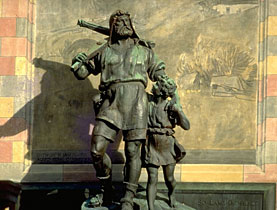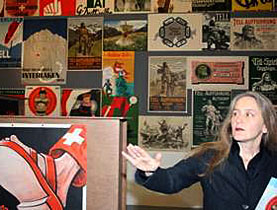Following Tell’s arrow back to the source

The story of William Tell, Swiss patriot and national symbol, is famous throughout the world and a source of pride in his home village in central Switzerland.
Bürglen still hosts evidence of the legendary figure, whose apple-shooting feat helped to cement Switzerland’s identity and has inspired legions of artists and authors.
This picturesque village in canton Uri – set against the majestic peaks of the Alps – is where Tell, a farmer and family man, is said to have lived in the Middle Ages.
“He was a quiet man, a mountain dweller and a good hunter,” Lisbeth Grossrieder, my guide and herself a Bürglen resident.
It is still possible to see the site where, according to local tradition, his house once stood. A chapel, dating from 1582 and dedicated to Tell, has now been erected in its place.
Passing by the Tell statue – a more modest one than the famed bronze in Altdorf, the nearby capital of Uri – we come to the Tell museum.
Here we learn that life would have been hard for farmers at the time, with many eking out a living.
It was also a time of political turmoil. The region stood under the protection of the Habsburg Emperor, who wanted to extend his power.
The hardy mountain people held out. In 1291, three cantons, Schwyz, Uri and Unterwalden, came together to swear an oath of mutual support on the Rütli meadow near Lake Lucerne – an event regarded as the foundation of the Swiss Confederation.
Reluctant hero
In the Tell story, an Austrian bailiff, Gessler, was sent to Altdorf. On November 18, 1307, he set about testing the locals’ allegiance to the Habsburgs by ordering them to bow to a pole with his hat on top.
Tell, in Altdorf with his little son, Walter, ignored the request.
“Tell became embroiled in these events without wanting to; he only wanted to go to Altdorf market and visit his father-in-law,” said Grossrieder.
Tell was arrested and as a punishment ordered to shoot an apple from Walter’s head, or both father and son would face execution. Tell did so with a single shot from his crossbow.
The huge bronze statue of Tell, and Walter, now stands near the reputed site in Altdorf.
It was chosen via a competition in the 19th century and the small mock-ups submitted by the local leading sculptors of the day can still be seen in the museum.
It is easy to see why Zurich artist Richard Kissling’s version, with its serene and powerful-looking Tell, crossbow slung across his shoulders, and adoring Walter, was selected. It has now become one of the most iconic images of the legendary figure.
A black-and-white photograph shows how, at its inauguration in 1895, the monument drew huge crowds of people to Altdorf.
Watery escape and death
But the story does not end there. Gessler, on finding out that Tell’s second shot would have been aimed at him had the archer missed, ordered Tell to be imprisoned at his castle at Küssnacht on the shores of Lake Lucerne.
However, on the way there a terrible storm arose and threatened to sink the boat. Tell, almost as good a steersman as crossbowman, was told to take over.
He used the opportunity to escape. He later gained his revenge, killing Gessler with his second bolt. The news of his deed spread quickly, allegedly inspiring the independence movement in the area.
According to Bürglen lore, Tell met his death – in a suitably heroic way – aged 52, when he drowned in the River Schächen saving a child.
Not much else is known about Tell or his family. In the interests of equality, however, Bürglen residents have also honoured the long-forgotten Mrs Tell with her own statue.
“We don’t know if Tell really existed. There are lots of controversies,” Grossrieder said. “Historians think that probably something important happened around this time but we can’t say what exactly.”
The story was passed down orally through the generations because people could not read and write. “Altdorf burned down three times so lots of documents of the time were lost,” she added.
Tell is first mentioned in a 15th-century historical chronicle. The apple-shooting episode, found in other ballads of the period in Europe, may well have its origins in the tale of the Danish hero Toko.
Schiller and Goethe
The story came to wider attention after German literary great Goethe visited Altdorf in the late 1700s.
“He went to his friend Schiller in Weimar, told him the story and made it come alive. Schiller then set about writing his wonderful play. Since then we have been famous,” said Grossrieder.
Indeed, the locals have no quibble with Tell as depicted by Schiller, who wrote the work despite being too ill with tuberculosis to travel to Uri himself.
For more than a century Altdorf residents have been staging the play themselves. This year’s dramatisation is a modern take on the legend.
National and local psyche
William Tell is now part of the Swiss national psyche, standing for freedom – images of Tell were revived during the Second World War – and his crossbow, for Swiss quality.
A 2004 survey found that 60 per cent of Swiss said they believed the story.
Although Tell is very much in evidence in the village, Bürglen tends to remember its hero modestly.
There may be a Tell Hotel in Bürglen and even a William Tell pizzeria in Altdorf, but you won’t find many tourist shops full of mini crossbows or T-shirts with targets on them.
There is, however, still undeniable pride in their famous son. “There’s a saying in Bürglen,” says Grossrieder. “Did Tell exist? Perhaps. But he certainly killed Gessler!”
swissinfo, Isobel Leybold-Johnson in Bürglen and Altdorf
Bürglen is the traditional birthplace of Tell – landmarks include the Tell chapel with frescos, the Tell statue and the Tell Museum. Altdorf is where he is reputed to have shot the apple from his son’s head. It is the site of the famous bronze statue of Tell and Walter.
Tell Plays 2008 in Altdorf – a modern version of Schiller’s classic will take place August 16-October 18. Volker Hesse is the German director in charge.
Other Tell-themed places to visit: the Rütli meadow, high above Lake Lucerne, and Tell’s Chapel on the corner of the lake where legend has it that Tell saved himself with a leap out of Gessler’s boat.
This article is one of three on sites from the new book, “Geschichte Erleben in Herzen der Schweiz” (Experiencing history in the heart of Switzerland), published by Switzerland Archaeology.
It contains 135 sites, from prehistoric times to the 20th century, from six central Swiss cantons: Lucerne, Nidwalden, Obwalden, Schwyz, Uri and Zug.
Switzerland Archaeology’s Urs Niffeler told swissinfo the idea for the book came about because there were many “hidden historical gems” that people did not know about in these regions.
The book contains short information on the site and how to get there. It currently exists in German and French and can be obtained via Swiss Archaeology.

In compliance with the JTI standards
More: SWI swissinfo.ch certified by the Journalism Trust Initiative











You can find an overview of ongoing debates with our journalists here . Please join us!
If you want to start a conversation about a topic raised in this article or want to report factual errors, email us at english@swissinfo.ch.